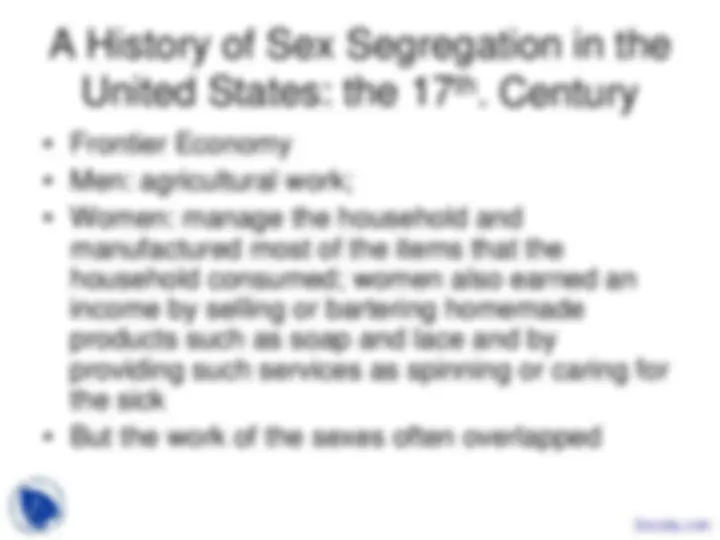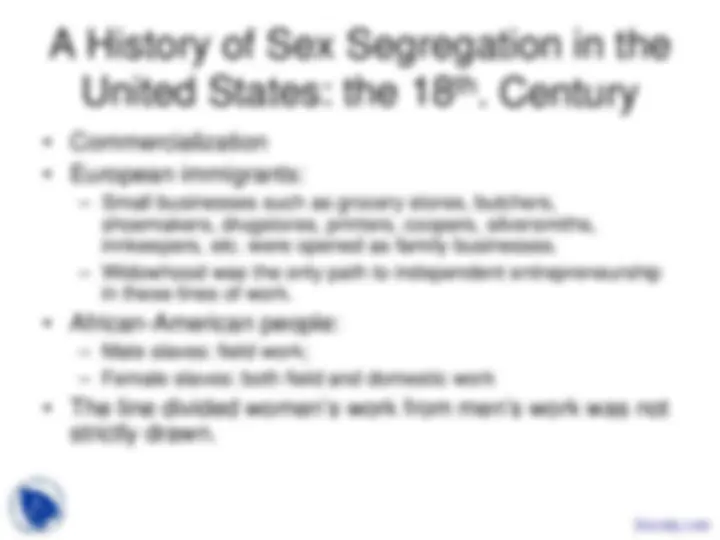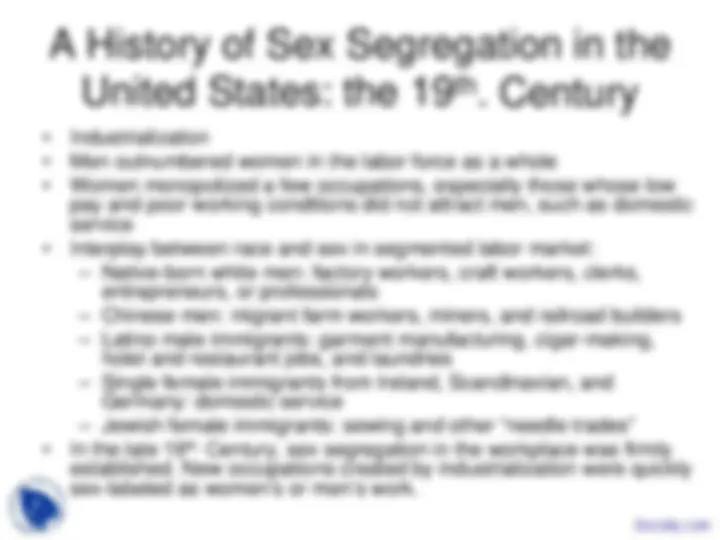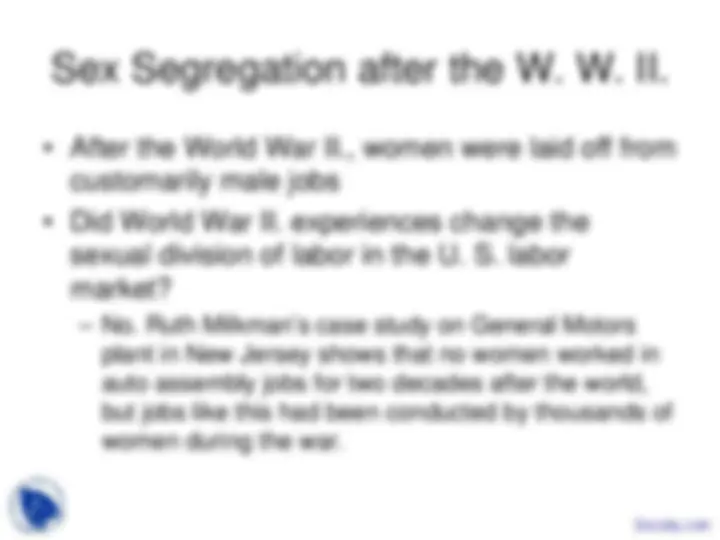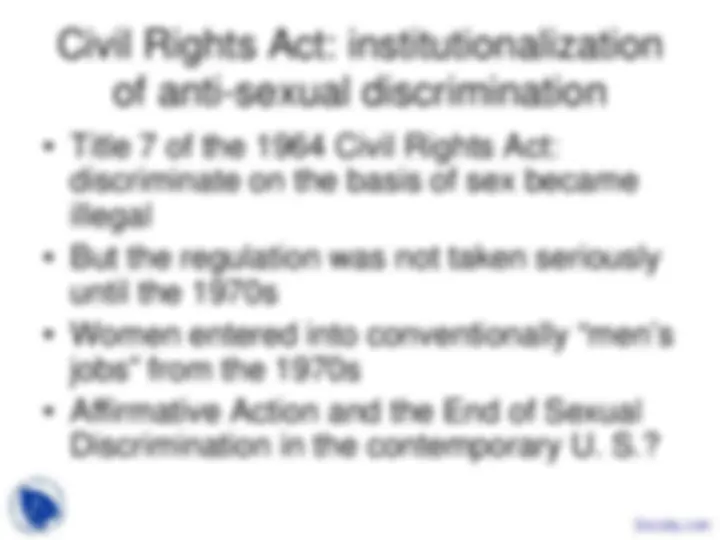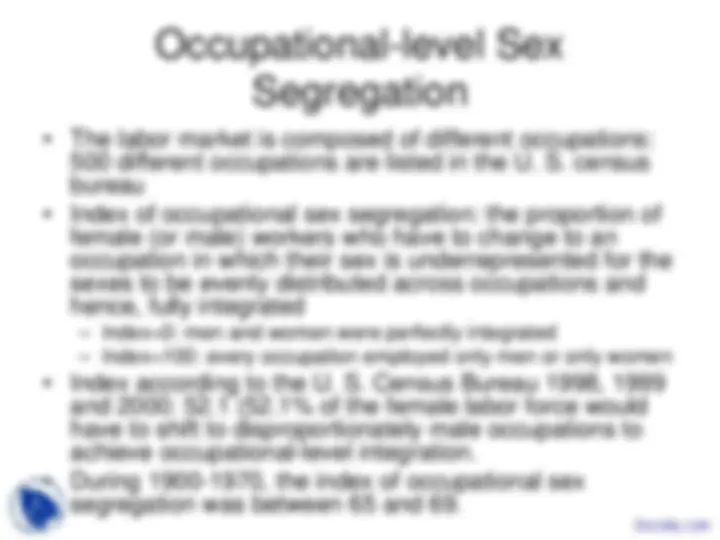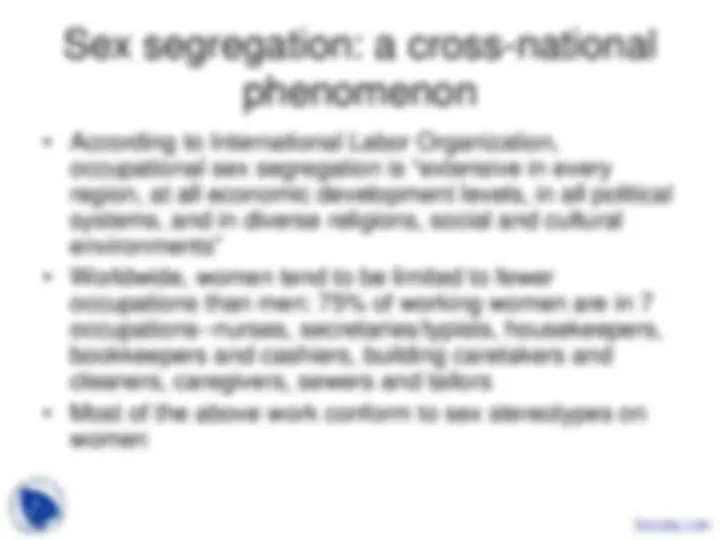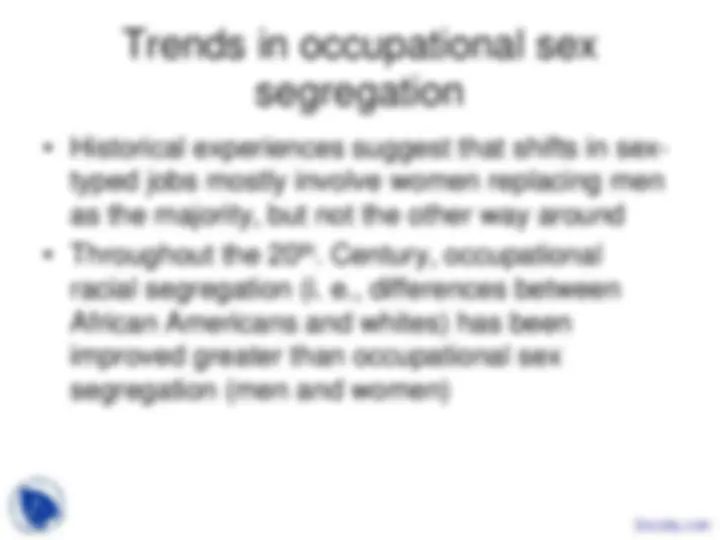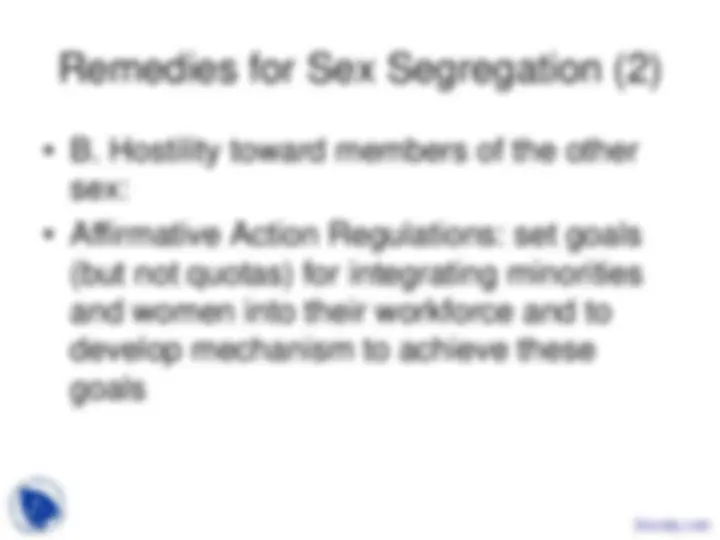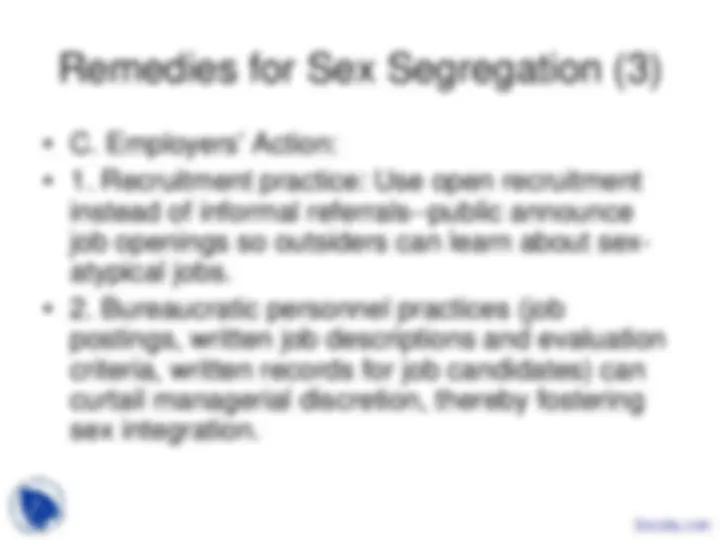Download Sex Segregation - Sex Inequality - Lecture Slides and more Slides Psychology of Sex in PDF only on Docsity!
Lecture Note 5
Sex Segregation in the Workplace
Sex Segregation
- Definition: the different distributions of men and women across different occupations, jobs, and places of work.
- Consequences:
- It lowers women’s earnings relative to men. Why?
- A. Women tend to be overrepresented in lower-paying jobs and men in higher-paying ones;
- B. Occupations that are predominantly female tend to pay less to both male and female incumbents than predominantly male occupations pay.
- Once jobs and equipment are designed with a certain sex in mind, segregation tends to perpetuate itself.
- E. g. women would receive less on-the-job training that they cannot move into better or less-segregated jobs.
A History of Sex Segregation in the
United States: the 18 th^. Century
- Commercialization
- European immigrants:
- Small businesses such as grocery stores, butchers, shoemakers, drugstores, printers, coopers, silversmiths, innkeepers, etc. were opened as family businesses.
- Widowhood was the only path to independent entrepreneurship in these lines of work.
- African-American people:
- Male slaves: field work;
- Female slaves: both field and domestic work
- The line divided women’s work from men’s work was not
strictly drawn.
A History of Sex Segregation in the
United States: the 19 th^. Century
- Industrialization
- Men outnumbered women in the labor force as a whole
- Women monopolized a few occupations, especially those whose low pay and poor working conditions did not attract men, such as domestic service
- Interplay between race and sex in segmented labor market:
- Native-born white men: factory workers, craft workers, clerks, entrepreneurs, or professionals
- Chinese men: migrant farm workers, miners, and railroad builders
- Latino male immigrants: garment manufacturing, cigar-making, hotel and restaurant jobs, and laundries
- Single female immigrants from Ireland, Scandinavian, and Germany: domestic service
- Jewish female immigrants: sewing and other “needle trades”
- In the late 19 th.^ Century, sex segregation in the workplace was firmly established. New occupations created by industrialization were quickly sex-labeled as women’s or men’s work.
Sex Segregation before the W. W. II.
Men joined the army,
women were recruited to
take over the “men’s
work”
customarily male jobs, a
slogan was circulated :
“If you can run a sewing
machine, you can
operate a rivet gun.”
Sex Segregation after the W. W. II.
- After the World War II., women were laid off from
customarily male jobs
- Did World War II. experiences change the
sexual division of labor in the U. S. labor
market?
- No. Ruth Milkman’s case study on General Motors plant in New Jersey shows that no women worked in auto assembly jobs for two decades after the world, but jobs like this had been conducted by thousands of women during the war.
Occupational-level Sex
Segregation
- The labor market is composed of different occupations: 500 different occupations are listed in the U. S. census bureau
- Index of occupational sex segregation: the proportion of female (or male) workers who have to change to an occupation in which their sex is underrepresented for the sexes to be evenly distributed across occupations and hence, fully integrated - Index=0: men and women were perfectly integrated - Index=100: every occupation employed only men or only women
- Index according to the U. S. Census Bureau 1998, 1999 and 2000: 52.1 (52.1% of the female labor force would have to shift to disproportionately male occupations to achieve occupational-level integration.
- During 1900-1970, the index of occupational sex segregation was between 65 and 69.
Top 10 Occupations for Each Sex, 2000 (Renkin and Padavic, p. 66)
Women (total labor force: 65983000) Men (total labor force: 74627000)
Secretaries 2984000 4.5%
Managers and administrators, n. e. c. 5487000 7.4%
Managers and administrators, n. e. c. 2518000 3.8%
Supervisors and proprietors, sales occupations 3054000 4.1%
Cashiers 2490000 3.8% Truck drivers 2958000 4.0% Supervisors and proprietors, sales occupations 2042000 3.1% Janitors and cleaners 1614000 2.2%
Registered nurses 1974000 3.0% Carpenters 1410000 1.9%
Teachers, elementary 1844000 2.8% Cooks 1300000 1.7% Nursing aides, orderlies, and attendants 1833000 2.8%
Computer systems and analysts and scientists 1166000 1.6%
Bookkeepers, accounting and auditing clerks 1736000 2.6%
Sales representatives, mining, manufacturing, and wholesale 1164000 1.6%
Waiters and waitress 1165000 1.8%
Laborers, except construction 1058000 1.4%
Receptionists 1090000 1.7%
Supervisors, production occupations 960000 1.3%
Establishment-level Segregation
• DF: the differing distributions of women
and men who pursue the same
occupations across different
establishments
• Example: female state prison guards in
female prisons; male guards in male
prisons
Sex segregation: a cross-national
phenomenon
- According to International Labor Organization,
occupational sex segregation is “extensive in every region, at all economic development levels, in all political systems, and in diverse religions, social and cultural environments”
- Worldwide, women tend to be limited to fewer
occupations than men: 75% of working women are in 7 occupations--nurses, secretaries/typists, housekeepers, bookkeepers and cashiers, building caretakers and cleaners, caregivers, sewers and tailors
- Most of the above work conform to sex stereotypes on
women
Indexes of Occupational Sex and
Race Segregation, 1900-
Padavic and Reskin (2002: 73) Docsity.com
Remedies for Sex Segregation (1)
- A. Gender Ideology (sex stereotypes; sex
labeling of occupations and jobs);
- Change languages as well as occupations’
sex labels:
- stewardess flight attendants;
- Mailman letter carriers;
- Fireman firefighters;
- Waitress/ waiters waitperson or servers.
An example (and controversy) of
setting goals for integrating minorities
- Can we give people from “subordinate groups” (such as women and people of color) special advantages to get a job or to access to education?
- Example: The Admission Lawsuits against the University of Michigan (see the report) - Do you agree with the school’s attempt to achieve diversity? - Does the school’s recruitment policy violate the principle of fairness? (How were the cases closed? check here)
Ballot
Result and analysis
Remedies for Sex Segregation (3)
- C. Employers’ Action:
- Recruitment practice: Use open recruitment
instead of informal referrals--public announce
job openings so outsiders can learn about sex-
atypical jobs.
- Bureaucratic personnel practices (job
postings, written job descriptions and evaluation
criteria, written records for job candidates) can
curtail managerial discretion, thereby fostering
sex integration.

